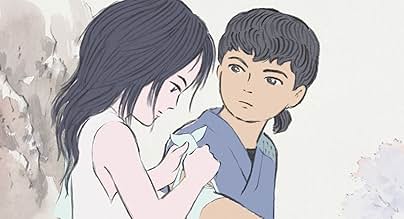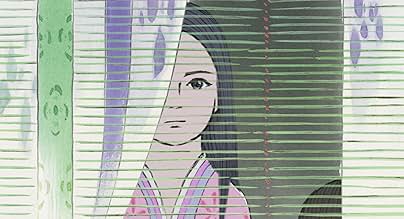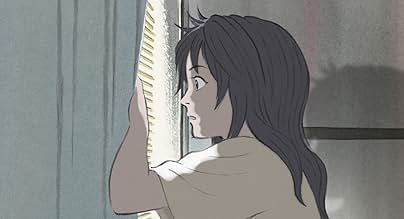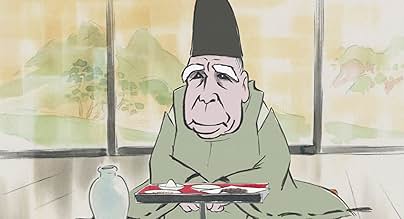Una misteriosa joven princesa cautiva a todos los que la encuentran, pero finalmente debe enfrentar su destino, el castigo por su crimen.Una misteriosa joven princesa cautiva a todos los que la encuentran, pero finalmente debe enfrentar su destino, el castigo por su crimen.Una misteriosa joven princesa cautiva a todos los que la encuentran, pero finalmente debe enfrentar su destino, el castigo por su crimen.
- Dirección
- Guionistas
- Elenco
- Nominado a 1 premio Óscar
- 13 premios ganados y 38 nominaciones en total
Chloë Grace Moretz
- The Princess Kaguya
- (English version)
- (voz)
James Caan
- The Bamboo Cutter
- (English version)
- (voz)
Mary Steenburgen
- The Bamboo Cutter's Wife
- (English version)
- (voz)
- …
James Marsden
- Prince Ishitsukuri
- (English version)
- (voz)
Aki Asakura
- Kaguya hime
- (voz)
- …
Kengo Kôra
- Sutemaru
- (voz)
Takeo Chii
- Okina
- (voz)
Nobuko Miyamoto
- Ôna
- (voz)
- …
Opiniones destacadas
I've already watched this film 3 times! I was deeply moved and couldn't stop crying every time.
I believe that "Princess Kaguya" is the best Ghibli film in the past 10 years because of the beautiful hand-drawn animation and touching story.
Japanese audience and critics are also very positive for this film, compared to other Ghilbi films.
Hayao Miyazaki is a genius but his recent films are always controversial since "Haul's Moving Castle".
One of the reason is that he relies on his imagination and makes light of a script. That's why quite a few people can't fully understand his recent films and sometimes blame them. ("The Wind Rises" was a tragedy in this meaning.)
Isao Takahata, the director of "Princess Kaguya", is a very good director known for "The Grave of Firefly" but not so active since "My neighbor the Yamada".
His philosophy is very different from that of Hayao Miyazaki. Isao Takahata thinks the scenario is very important and he prefers realism to fantasy.
"Princess Kaguya" is based on the Japanese oldest folklore "The Tale of the Bamboo Cutter". But Isao Takahata transforms it into a universal humanistic story by describing Princess Kaguya as a realistic girl.
This film contains many fantastic scenes and they play as good eye candies. But the brilliantly illustrated life and emotions of the heroine is the most important part in this film. And that's what the director wants us to try to sympathize.
The beautiful and artistic style of this animation is suitable for this theme. Because this apparently unfinished animation gives us the room to imagine by ourselves.
Isao Takahata says, "The animations tend to deprive children of their own imagination by pushing them someone else's fantasy. We have to make another animation which let them imagine by themselves".
I can't wait to see the responses from the worldwide audience! Hope you will like this film too!
I believe that "Princess Kaguya" is the best Ghibli film in the past 10 years because of the beautiful hand-drawn animation and touching story.
Japanese audience and critics are also very positive for this film, compared to other Ghilbi films.
Hayao Miyazaki is a genius but his recent films are always controversial since "Haul's Moving Castle".
One of the reason is that he relies on his imagination and makes light of a script. That's why quite a few people can't fully understand his recent films and sometimes blame them. ("The Wind Rises" was a tragedy in this meaning.)
Isao Takahata, the director of "Princess Kaguya", is a very good director known for "The Grave of Firefly" but not so active since "My neighbor the Yamada".
His philosophy is very different from that of Hayao Miyazaki. Isao Takahata thinks the scenario is very important and he prefers realism to fantasy.
"Princess Kaguya" is based on the Japanese oldest folklore "The Tale of the Bamboo Cutter". But Isao Takahata transforms it into a universal humanistic story by describing Princess Kaguya as a realistic girl.
This film contains many fantastic scenes and they play as good eye candies. But the brilliantly illustrated life and emotions of the heroine is the most important part in this film. And that's what the director wants us to try to sympathize.
The beautiful and artistic style of this animation is suitable for this theme. Because this apparently unfinished animation gives us the room to imagine by ourselves.
Isao Takahata says, "The animations tend to deprive children of their own imagination by pushing them someone else's fantasy. We have to make another animation which let them imagine by themselves".
I can't wait to see the responses from the worldwide audience! Hope you will like this film too!
10Whazabey
I was a bit anxious before seeing this movie because it is not from Miyazaki but after seeing it I can say that there was no reason to be anxious about this movie. It's probably the most beautiful movie I've ever seen and it is equally as good, if not even better as spirited away and princess mononoke. The story is wonderfully told and it has some extremely sad moments. But probably the best thing about this movie is the breath taking animation. It's just incredibly beautiful and just so unique that you just won't forget it. As always for a Ghibli movie the movie has an eye for detail and you just feel the passion which was put into this movie. This movie was one of the best anime I have ever seen and probably also one of the best movies I have ever seen.
I liked this to a good extent, and my rating goes up because of the last 15 minutes, which are so magnificent. Those last several minutes and the first act are truly brilliant, but for some reason, the film sort of lost me in its middle and a little more than that. Not completely lost me, but it did get a little too much and it got to less interesting overall. I can't say I completely agree with the critical acclaim it's gotten, but I think it's a good, sometimes very good, film, definitely made stronger because of certain scenes. The sound mixing here is incredible, and the voice acting (in its original language) is pretty fantastic as well. Overall, still recommended but with reservations, yeah.
With the exception of the energetic The Lego Movie, this year has been a disappointment for the animated genre. What a relief then it is that Isao Takahata's (Grave of the Fireflies) new film is a triumphant success.
Based on a 10th century Japanese folktale, The Tale of Princess Kaguya is a bittersweet coming of age story. Our protagonist is Kaguya-hime who is discovered as a baby in a bamboo stalk by an old peasant man. He and his childless wife raise her as their own, providing the best they can as she rapidly ages. While her mother is fearful of change and just wants a comfortable life for her adopted daughter, her father envisions great things. He sees Kaguya as part of a divine plan and after fine clothes and gold come shooting out of bamboo stalks he concludes that the heavens want her to become a proper princess. He assumes this is the best way to make his daughter happy instead of asking her what she wants.
A sharply observed feminist critique of traditional Japanese culture as well as a cautionary tale of the burdens we place on our children, The Tale of Princess Kaguya has a wealth of complex themes and archetypes hidden beneath the surface of its fairly straight- forward story. This is one of the rare films that are both easily accessible to a young audience and one that film students can write thesis papers on.
The final word should be reserved for Studio Ghibli's animation. The style used invokes something between impressionist paintings and water-colours while employing a muted palette. Ghibli moves away from traditional anime and the results are breathtaking. The hand drawn frames could each stand alone as a portrait and yet the film feels fluid. At times the animation blurs into expressionism; the brush strokes matching the characters inner- turmoil.
Easily the best animated film of the year, it's a must see for fans of the genre. Luckily North America will get a theatrical release; the English-dubbed version will be out October 17 and will star Chloe Grace Moretz as Kaguya.
Based on a 10th century Japanese folktale, The Tale of Princess Kaguya is a bittersweet coming of age story. Our protagonist is Kaguya-hime who is discovered as a baby in a bamboo stalk by an old peasant man. He and his childless wife raise her as their own, providing the best they can as she rapidly ages. While her mother is fearful of change and just wants a comfortable life for her adopted daughter, her father envisions great things. He sees Kaguya as part of a divine plan and after fine clothes and gold come shooting out of bamboo stalks he concludes that the heavens want her to become a proper princess. He assumes this is the best way to make his daughter happy instead of asking her what she wants.
A sharply observed feminist critique of traditional Japanese culture as well as a cautionary tale of the burdens we place on our children, The Tale of Princess Kaguya has a wealth of complex themes and archetypes hidden beneath the surface of its fairly straight- forward story. This is one of the rare films that are both easily accessible to a young audience and one that film students can write thesis papers on.
The final word should be reserved for Studio Ghibli's animation. The style used invokes something between impressionist paintings and water-colours while employing a muted palette. Ghibli moves away from traditional anime and the results are breathtaking. The hand drawn frames could each stand alone as a portrait and yet the film feels fluid. At times the animation blurs into expressionism; the brush strokes matching the characters inner- turmoil.
Easily the best animated film of the year, it's a must see for fans of the genre. Luckily North America will get a theatrical release; the English-dubbed version will be out October 17 and will star Chloe Grace Moretz as Kaguya.
Before watching the movie, the animation style of the movie caused me serious hesitation. I thought it was outdated and unimpressive. I was worried that it would bore me while watching it. I was quite wrong. This animation style was chosen specifically to convey the fable atmosphere and feeling to the audience. And it was very convenient.
I really appreciated how much effort was put into capturing the atmosphere of the original material. I haven't read the original material so I don't know how faithful it is to the original as a story, but I also liked the things I thought the movie said about women, life, and women's place in society.
I felt like the story was dragging its feet in places. I generally expect fable-style stories to be faster so that they can appeal to a wider audience and not cause you to start questioning the surreal world.
I want to repeat it for the last time. If you want to experience a fable, there are few, if any, better options to watch.
I really appreciated how much effort was put into capturing the atmosphere of the original material. I haven't read the original material so I don't know how faithful it is to the original as a story, but I also liked the things I thought the movie said about women, life, and women's place in society.
I felt like the story was dragging its feet in places. I generally expect fable-style stories to be faster so that they can appeal to a wider audience and not cause you to start questioning the surreal world.
I want to repeat it for the last time. If you want to experience a fable, there are few, if any, better options to watch.
¿Sabías que…?
- TriviaIn several scenes in the movie, Kaguma-Hime, Lady Sagami and Ona can be seen wearing multi-layered kimonos called Junihitoe. Both the number of layers and the coloring of the layers worn would be dictated by the occasion, status, and season the wearer is in.
- ErroresWhile the baby princess crawls to the cutter she tosses a piece of bamboo to the edge of the floor mat. In the reverse shot as she crawls back, it is missing.
- Citas
The Princess Kaguya: [singing] Go round, come round, come round... Come round, oh distant time. Come round, call back my heart. Come round, call back my heart. Birds, bugs, beasts, grass, trees, flowers. Teach me how to feel. If I hear that you pine for me, I will return to you.
- ConexionesFeatured in Troldspejlet: Episode #50.12 (2014)
Selecciones populares
Inicia sesión para calificar y agrega a la lista de videos para obtener recomendaciones personalizadas
- How long is The Tale of The Princess Kaguya?Con tecnología de Alexa
Detalles
Taquilla
- Presupuesto
- JPY 5,000,000,000 (estimado)
- Total en EE. UU. y Canadá
- USD 974,913
- Fin de semana de estreno en EE. UU. y Canadá
- USD 54,915
- 19 oct 2014
- Total a nivel mundial
- USD 24,751,400
- Tiempo de ejecución2 horas 17 minutos
- Color
- Mezcla de sonido
- Relación de aspecto
- 1.85 : 1
Contribuir a esta página
Sugiere una edición o agrega el contenido que falta

Principales brechas de datos
What is the streaming release date of El cuento de la princesa Kaguya (2013) in Australia?
Responda































